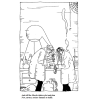This is the first illustration in the book, and it is a clear tone-setter for the entire theme of the Prohibition-centered parody. Some might say, ‘of course illustrations lend to a bigger picture’, but I would say that this one especially does the job. The government does not see citizens as people, as people who live and laugh and love, but a vote to obtain for their next election, or sheep to herd in their next law- that’s what J.L. Duff sets the tone as in the first stanza, and strengthens it with the illustration of two scientists: equating calculative, precise scientists to government officials who are supposed to be caring and thoughtful to their citizens. Now, set in place, we see two men hovering over what seems to be a chemical lab, debating on a few different vials, scheming something: it is quite the illustration, and the text underneath helps cement us- as it is from the first stanza of the entire miniature book.
The first stanza:
Wail! for the Law has scattered into flight
Those Drinks that were our sometime dear Delight;
And still the Morals-tinkers plot and plan
New, sterner, stricter Statutes to indite.
The defining text:
And still the Morals-tinkers plot and plan
New, sterner, stricter Statutes to indite.
With the lines of ‘moral-tinkers plot’ and ‘stricter statutes’, we are set into the scene of the twentieth century alcohol ban. If you were to open Rubáiyát of Ohow Dryyam, you’d see stanza one and two, and then your eyes would shift to see this illustration, with the determining text underneath. And I believe that it’s the ‘hook’ of the book. As we open books, our eyes don’t necessarily draw to the words first, but to the layout and essence of the book- and especially, if there’s an illustration. Because of this effect, we already have this illustration of scheming men, and then we work into the defining text, and THEN the first stanza. As we have already seen the later half of the first stanza, we have the ability to understand it more. That “morals-tinkers plot and plan/ New, sterner, stricter Statues to indite” sets the tone of the government did not think of their citizens as people with lives, but as a way to push their own narratives and morals onto them.
Because of this immediate tone set, we can see how well J.L Duff has reeled us in. Any good writer knows that if we don’t intrigue our reader within the first bit, then they might not continue, and we don’t want that. Ohow Dryyam is a perfect example of grabbing that attention because the text is not complex- whereas some of the other stanzas may be such as:
‘The Bird of Time flies with a steadier wing
But roosts with sleepless Eye—a Coffee Souse!”
(stanza 7)
Reading wouldn’t be fun if we didn’t have to search for a deeper meaning within the words; however, to allow the reader to submerge themselves into a certain piece, it needs to be digestible within its ground rules. And that’s what our enticing first illustration and stanza does. Not only does it lay out the table for us, with a nice table-cloth and silverware with plates and a five-course meal, but this pair of picture and words goes further than just the parody of Rubáiyát of Omar Khayyám. It goes beyond making us want to finish the parody’s fifteen pages, but makes us think about the morality of how American law can dictate our actions. How people of power can make us submit and whether it is truly for the betterment of the country- all that is set-up in the illustration and defining text of the opening. ‘Moral-tinkers’ especially sets in frame what government officials are doing by restricting alcohol: using their own moral compasses for the masses- which is inherently the opposite of America’s ‘land of the free’ motto and all.
In conclusion, if one picture can completely set-up the future reading AND future questions about how a certain country runs, then it is a great hook!


